

Questioning That Deepens Comprehension. Editor's note: This post is co-authored by Nancy Frey, a Professor of Literacy in Educational Leadership at San Diego State University and a credentialed special educator, reading specialist, and administrator.
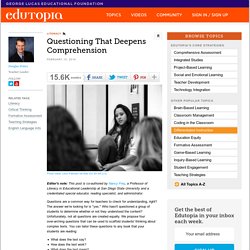
Questions are a common way for teachers to check for understanding, right? The answer we’re looking for is "yes. " Who hasn't questioned a group of students to determine whether or not they understood the content? Unfortunately, not all questions are created equally. We propose four over-arching questions that can be used to scaffold students' thinking about complex texts.
What does the text say? What does the text say? The questions in this category require students to think literally about the text. The amount of time that teachers spend at the literal level will vary based on student responses. Questions at this level could include: What is the relationship between the narrator and the main character? Choice Literacy - Articles & Videos - Full Article.
Some time ago I had the opportunity to read an early copy of R.J.

Palacio’s debut novel, Wonder . I’d heard about it through friends and eagerly anticipated reading it. The book took my breath away. The next spring brought opportunities to meet the author, talk about the book with colleagues, and read it to my class. With my fifth graders was amazing. When given the choice between being right or being kind, choose kind. I knew then that the book had touched the students. Throughout the year. As summer began I heard about the movement Random House and R.J. When recommending Wonder to my mom this summer, I told her that my mission was for everyone in our town to read this book.
With the start of the school year just around the corner, I scheduled a lunch with my school’s librarian. With the idea of sharing one book with the entire school, we began running through questions and discussing ideas. ? Another possible tie-in is our Family Reading Night this fall. 17 Best images about Mentor Texts for Nonfiction Text Structures on Pinterest. Make love of reading the first objective. The myths we allow ourselves to believe about reading will continue to shape the reading lives of those we teach.
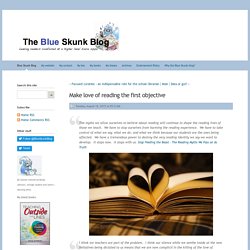
We have to stop ourselves from harming the reading experience. We have to take control of what we say, what we do, and what we think because our students are the ones being affected. We have a tremendous power to destroy the very reading identity we say we want to develop. It stops now. It stops with us. I think we teachers are part of the problem. I don't know about you, but... Each of these posts emphasize that teaching the skills of reading is not enough. Choice Literacy - Articles & Videos - Full Article.
Trelease Brochures on Reading. "Do you have a free handout about reading that we can give to parents?
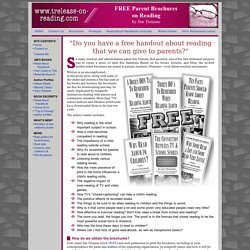
" o many teachers and administrators asked Jim Trelease that question, one of his first retirement projects was to create a series of such free handouts. Based on his books, lectures, and films, the tri-fold double-sided brochures are aimed at parents, teachers, librarians—even future teachers and parents.
50 Ways to Use Picture Books w ELA Students Final Handout. 12 Ways to Nurture a Love of Reading. As a classroom teacher, nurturing a love of reading in my students was almost an obsession.
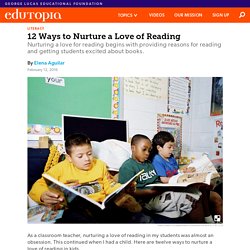
This continued when I had a child. Here are twelve ways to nurture a love of reading in kids. 10 Tips to Create Great Readers. Great readers are made; they are not born (to paraphrase Vince Lombardi).
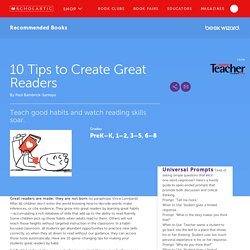
After all, children don’t enter the world knowing how to decode words, make inferences, or cite evidence. They grow into great readers by learning great habits—accumulating a rich database of skills that add up to the ability to read fluently. Some children pick up those habits when adults read to them. Others will not reach those heights without targeted instruction in the classroom. In a habit-focused classroom, all students get abundant opportunities to practice new skills correctly, so when they sit down to read without our guidance, they can access those tools automatically. 1 | Build habits at the moment of error, not at the moment of success. Guess My Lexile - The Book Whisperer. What do Jeff Kinney's popular Diary of a Wimpy Kid and Ray Bradbury's classic Fahrenheit 451 have in common?
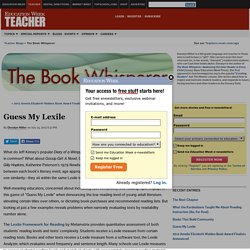
What about Gossip Girl: A Novel, Cicely von Ziegesar's catty romance and The Great Gilly Hopkins, Katherine Paterson's 1979 Newbery Honor book? While clear distinctions exist between each book's literary merit, age appropriateness, and reader appeal, these titles possess one similarity--they sit within the same Lexile text complexity band.** Well-meaning educators, concerned about increasing text complexity and reading rigor, engage in this game of "Guess My Lexile" when denouncing the low-reading level of young adult literature, elevating certain titles over others, or dictating book purchases and recommended reading lists.
The Lexile Framework for Reading by Metametrix provides quantitative assessment of both students' reading levels and texts' complexity. Meeting Readers Where They Are: Mapping the intersection of research and practice. Meeting Readers Where They Are: Mapping the intersection of research and practice The reading patterns and habits of young and old are changing as reading migrates from the printed page to the computer screen.
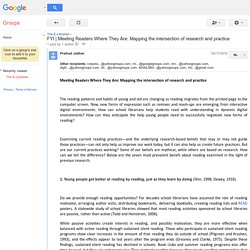
Position Statement on Labeling Books with Reading Levels. The following position statement is currently under review to align with the National School Library Standards.
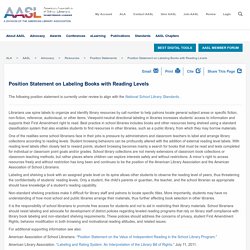
Librarians use spine labels to organize and identify library resources by call number to help patrons locate general subject areas or specific fiction, non-fiction, reference, audiovisual, or other items. Viewpoint-neutral directional labeling in libraries increases students’ access to information and supports their First Amendment right to read. Best practice in school libraries includes books and other resources being shelved using a standard classification system that also enables students to find resources in other libraries, such as a public library, from which they may borrow materials. School Librarian's Role in Reading Toolkit.